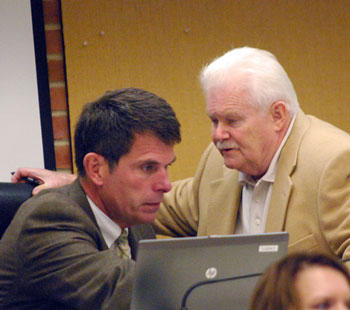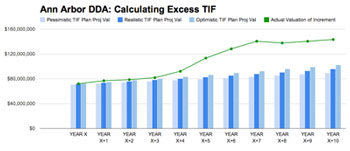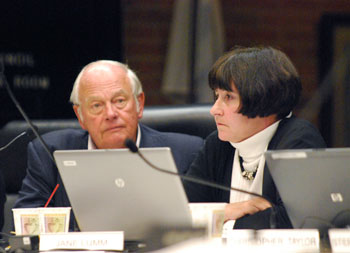The council’s post-holiday meeting agenda signals the end of summer and a reminder of work the council left unfinished several weeks earlier. Two items on the agenda were postponed until the Sept. 3, 2013 meeting at least seven weeks ago. The first is a revision to the ordinance regulating the Ann Arbor Downtown Development Authority. The second is a revision to the council’s own internal rules, which could have an immediate impact on the way conversations between the council and the DDA take place.

The sign on the door to the Ann Arbor city council chamber, installed in the summer of 2013, includes Braille.
For both agenda items, the expectation was that council committees would work during the interim period to hammer out a clarified proposal and recommendation for the full council to consider on Sept. 3. In neither case was that committee work accomplished.
After voting at its May 6, 2013 session to postpone a final vote on DDA ordinance revisions until Sept. 3, the council attempted to ensure that the deliberations at the first meeting of the fall would be productive. The council voted on July 1, 2013 to establish a joint council-DDA committee to work out a recommendation on possible legislation. The main point of controversy involves the definition of the DDA’s tax increment finance (TIF) capture.
Already given initial approval by the council is a proposal that would essentially enforce the existing ordinance language. The revision to the ordinance would have an arguably inconsequential impact on TIF revenue received by the DDA – when compared to its most recent 10-year planning document. What makes that comparison controversial, and unwelcome to the DDA staff and board, is the fact that its most recent planning document doesn’t include tax revenue from very recent new downtown construction. The revised ordinance would have a roughly $1 million per year negative impact on DDA TIF revenues – when compared to the amount the DDA would receive if the DDA were allowed to give the existing ordinance language its preferred interpretation.
The charge to the joint committee on July 1 was to begin meeting immediately, but the group did not convene until eight weeks later, on Aug. 26 – after the Aug. 6 Democratic primary election. The outcome of that election left a key vote in place for an ordinance revision that doesn’t favor the DDA – that of Stephen Kunselman (Ward 3), who defeated challenger Julie Grand. Still, DDA board members at the Aug. 26 meeting seemed keen to continue a delaying gambit. That’s because a failure by Jane Lumm (Ward 2) to win re-election in November could tip the balance in the DDA’s favor – even factoring in the addition of Jack Eaton in Ward 4. Eaton, who prevailed on Aug. 6 over incumbent Marcia Higgins, supports the idea of constraining the DDA’s TIF capture.
At the one committee meeting held so far, the only substantive concept that was batted around briefly was the idea of defining some kind of fixed cap on TIF revenue. This approach would replace the existing ordinance language, which calibrates the DDA’s TIF capture with the projections in the TIF plan. But the discussion never went as far as to include dollar amounts for the fixed cap. After about an hour and a half of political squabbling and sometimes inaccurate recitation of historical facts, the general mood among councilmembers seemed to be reflected in a remark by Sally Petersen (Ward 2): “I don’t think we can be there by next week.” So the item looks likely be postponed on Sept. 3. However, the council is free to vote the proposal up or down at this meeting.
The one session of the joint DDA-council committee still exceeded, by one meeting, the council rules committee’s effort over the summer. The rules committee did not meet at all between July 15, 2013 and Sept. 3. On July 15, the council had postponed a vote on new rules, but not before rejecting one of the proposed rule changes, which the committee had first presented on June 17, 2013. The council as a whole was not keen to shorten public commentary speaking turns. So the proposal currently in front of the council would maintain the existing three-minute time limit.
But as the council’s July 15 deliberations on other proposed rules changes threatened to bog down that meeting, Marcia Higgins (Ward 4), chair of the rules committee, encouraged a postponement until Sept. 3. In the interim, the committee – consisting of Higgins, Sabra Briere (Ward 1), Stephen Kunselman (Ward 3), Christopher Taylor (Ward 3), and mayor John Hieftje – was supposed to meet to consolidate input from other councilmembers and perhaps present a clean slate of proposed revisions.
Even though the rules committee didn’t meet, based on comments by Briere and Sumi Kailasapathy (Ward 1) at the Sunday night caucus on Sept. 1, they might push to eliminate all proposed revisions to the rules except for the one that had prompted the rules committee to consider some changes in the first place. The rules changes were prompted by a desire to allow for public commentary at council work sessions – to eliminate any question about whether councilmembers were engaged in deliberative interactions at those sessions. By allowing for public commentary at work sessions, the council would ensure compliance with Michigan’s Open Meetings Act. By enacting that rule change on Sept. 3, the council would be set for a fully deliberative work session on Sept. 9 – which is scheduled to be a joint session with the board of the DDA.
Three other significant items on the Sept. 3 agenda are tied together with an environmental thread. The council will be considering a resolution directing city staff to explore options with the Michigan Dept. of Environmental Quality and with the U.S. Environmental Protection Agency to help to set the clean-up requirements for 1,4-dioxane so that the Pall-Gelman plume is cleaned up to appropriate standards. The council will also be asked to act on a resolution urging the city’s employee retirement system to divest from fossil fuel companies. And finally, the council will consider a resolution directing staff to work with DTE on a pilot program for a “community solar” initiative.
More detail on other meeting agenda items is available on the city’s Legistar system. Readers can also follow the live meeting proceedings on Channel 16, streamed online by Community Television Network. The Chronicle will be filing live updates from city council chambers during the meeting, published in this article “below the fold.” The meeting is scheduled to start at 7 p.m. [Full Story]













